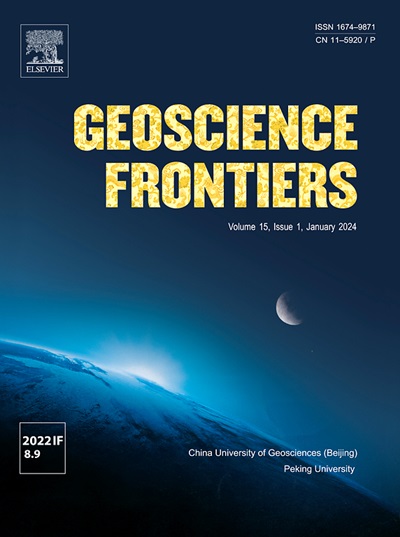Tracing carbonate diagenesis and hydrothermal activity during the opening of the Central South Atlantic: Insights from the Santos Basin (Brazil)
IF 8.9
1区 地球科学
Q1 GEOSCIENCES, MULTIDISCIPLINARY
引用次数: 0
Abstract
The opening of the Central South Atlantic and the consequent formation of the eastern Brazilian continental margin was marked by a complex history of mafic magmatism, carbonate sedimentation, and deposition of a thick salt layer. The carbonates underlying the salt layer (pre-salt carbonates) were formed in restricted lacustrine basins. Here, the timing and fluid sources of deposition, diagenetic, and hydrothermal alterations of the pre-salt carbonate rocks are defined through in-situ U-Pb dating, 87Sr/86Sr, and trace element analyses of samples from the Santos Basin. The very alkaline nature of the Aptian lake(s) produced characteristically unique and widely distributed carbonate rocks such as Mg-clays with calcite spherulite and calcite crystal shrub limestones transitioning laterally and vertically into travertines formed by hydrothermal pulses during basin evolution. Hydrothermalism caused extensive replacement, dissolution, and calcite cementation. REE+Y PAAS-normalised patterns and 87Sr/86Sr ratios indicate that deposition/eo-diagenesis of the primary carbonates occurred in a lacustrine environment primarily controlled by evaporation, pH, and continental water source, with 2%–10% hydrothermal fluid input. Trace elements and Sr-isotope of travertines and burial diagenetic phases show that they are produced from a hot mixture of mafic/mantle-derived fluids and dissolution/alteration of older carbonate formations. U-Pb dating indicates that carbonate deposition occurred between 124.8 ± 2.6 Ma and 120.0 ± 1.6 Ma, earlier than previously proposed, followed closely by the circulation of hydrothermal fluids. Replacement and cementation ages range from 120.5 ± 2.4 Ma to 80.4 ± 2.4 Ma.

南大西洋中部张开期间碳酸盐成岩作用和热液活动的示踪:来自巴西桑托斯盆地的启示
南大西洋中部的打开以及随之而来的巴西东部大陆边缘的形成,标志着一段复杂的基性岩浆作用、碳酸盐沉积和厚盐层沉积的历史。盐层下碳酸盐岩(盐下碳酸盐岩)形成于局限湖盆。通过对Santos盆地样品进行原位U-Pb测年、87Sr/86Sr测年和微量元素分析,确定了盐下碳酸盐岩沉积的时间、流体来源、成岩作用和热液蚀变。阿普田湖的强碱性形成了独特而广泛分布的镁质粘土、方解石球晶和方解石晶体灌丛灰岩等碳酸盐岩,它们在盆地演化过程中横向和纵向过渡为由热液脉冲形成的钙华。热液作用引起了广泛的置换、溶解和方解石胶结。稀土+Y paas正态模式和87Sr/86Sr比值表明,原生碳酸盐岩的沉积/成岩作用发生在主要受蒸发、pH和陆源水源控制的湖泊环境中,热液输入为2% ~ 10%。石灰华微量元素和sr同位素及埋藏成岩相表明,它们是由基性/幔源流体和古老碳酸盐地层溶蚀/蚀变的热混合作用产生的。U-Pb测年结果表明,碳酸盐岩沉积发生在124.8±2.6 Ma ~ 120.0±1.6 Ma之间,比前人预测的时间要早,与热液循环密切相关。置换和胶结年龄范围为120.5±2.4 Ma至80.4±2.4 Ma。
本文章由计算机程序翻译,如有差异,请以英文原文为准。
求助全文
约1分钟内获得全文
求助全文
来源期刊

Geoscience frontiers
Earth and Planetary Sciences-General Earth and Planetary Sciences
CiteScore
17.80
自引率
3.40%
发文量
147
审稿时长
35 days
期刊介绍:
Geoscience Frontiers (GSF) is the Journal of China University of Geosciences (Beijing) and Peking University. It publishes peer-reviewed research articles and reviews in interdisciplinary fields of Earth and Planetary Sciences. GSF covers various research areas including petrology and geochemistry, lithospheric architecture and mantle dynamics, global tectonics, economic geology and fuel exploration, geophysics, stratigraphy and paleontology, environmental and engineering geology, astrogeology, and the nexus of resources-energy-emissions-climate under Sustainable Development Goals. The journal aims to bridge innovative, provocative, and challenging concepts and models in these fields, providing insights on correlations and evolution.
 求助内容:
求助内容: 应助结果提醒方式:
应助结果提醒方式:


